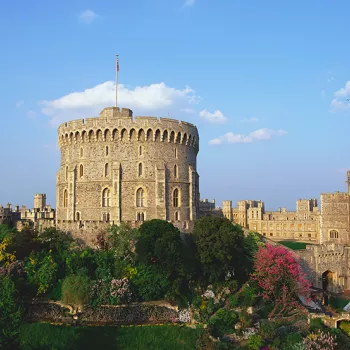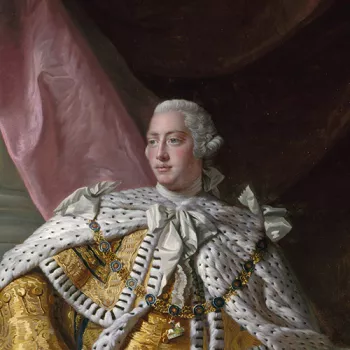Who lived at Windsor Castle?
While it was William the Conqueror who first built the castle, he didn’t live in the castle, it was used as a defensive base at the time. The Castle has been enlarged and restructured by different kings and queens during their reigns. Find out more about who built the Castle.
Henry I, Henry II, Henry III & Edward III
The first king to use Windsor Castle as a residence was Henry I. Henry’s marriage to Adela, the daughter of Godfrey of Louvain, took place in the Castle in 1121. The first Plantagenet king, Henry II, lived at Windsor and built extensively there between 1165 and 1179. Windsor was also one of the favourite residences of Henry III, and he invested heavily in the royal accommodation at the Castle during his reign from 1216. It was Edward III who left the greatest impression on Windsor in the 14th-century. Windsor was the intended centre of his court and government, and the seat of the newly founded Order of the Garter.
Henry V, Henry VII & Henry VIII
Windsor Castle continued to be a favoured royal residence in the 15th century. Under Henry V the Castle hosted a visit from the Holy Roman Emperor in 1417, a huge diplomatic event that stretched the accommodation of the Castle to its limits.
Henry VII made regular use of Windsor and, in 1488, held a huge feast for the Order of the Garter at the Castle. In the reign of his successor, Henry VIII, the Garter Feasts became more extravagant, and the size of the royal retinue visiting Windsor had to be restricted. During the Pilgrimage of Grace in 1536 - a huge uprising in the north of England against Henry’s rule - the King used Windsor as a secure base in the south from which to manage his military forces.
Edward VI, Elizabeth I & James I
The young Edward VI, who ruled from 1547-53 disliked Windsor. His Protestant beliefs led him to simplify the Garter ceremonies, to discontinue the annual Feast of the Garter and to remove any signs of Catholic practices with the Order. By contrast, Elizabeth I enjoyed spending time at Windsor. She used it increasingly for diplomatic engagements, although space at Windsor was not as large as the more modern royal palaces. Elizabeth’s successor in 1603, James I used Windsor primarily as a base for hunting, one of his favourite pursuits. The relatively small size of Windsor continued to prove problematic, and James’s English and Scottish retinues often quarrelled over rooms.
Charles I & Charles II
Charles I was a great connoisseur of art, and paid greater attention to the aesthetic aspects of Windsor Castle than his predecessors. He had the Castle surveyed by a team, including Inigo Jones, in 1629, but little of the recommended work was carried out.
At the height of the English Civil War (1642-51), the Castle was frequently used by Oliver Cromwell as his headquarters and a prison for captured royalist officers. In 1647 Charles I, then a prisoner of Parliament was brought to the Castle under arrest, before being moved to Hampton Court. Charles I was held at Windsor again for the last three weeks of his reign. After his execution on 30 January 1649, his body was taken back to Windsor by night through a snowstorm, to be interred without ceremony in the vault beneath St George’s Chapel.
Charles II loved Windsor, particularly in late summer and autumn, when there would be hunting and horse racing at nearby Datchet. When he came to the throne in 1660, the year of the restoration of the monarchy, he was determined to establish Windsor as his principal country residence and an important symbol of the restoration of the monarchy itself.
Queen Anne and George III
Among Charles II’s successors, William III preferred to spend his time at Hampton Court or Kensington Palace. Queen Anne, who ruled at the start of the 18th-century, retained a great deal of affection for Windsor, her birthplace. She purchased and enlarged a small 18th-century house, known as The Queen’s Garden House, on the south side of the Castle. Although as Queen she used her uncle Charles II’s modern State Apartments, the Garden House remained her favourite Windsor residence.
The early Hanoverian monarchs followed William III in favouring Hampton Court and Kensington Palace, and it was not until the reign of George III in 1760 that Windsor became once again an important centre of court life. For the first 20 years of his reign, the King made few changes, except for a vast extension to Queen Anne’s Garden House, which became known as the Queen’s Lodge. Partly designed by George III himself, it was the Windsor residence of the King and Queen and their growing family.
George IV
The monarch most closely associated with the appearance of the Castle today is George IV. He furnished the State Apartments in the grandest manner, partly incorporating fixtures and fittings from Carlton House, his former London residence. George IV’s work extended to the gardens surrounding the Castle, where on the east front he laid out a D-shaped formal garden bordered by raised walks and punctuated by numerous bronze statues and vases. The King did not take up residence at Windsor until the end of 1828. Sadly, he was only able to enjoy his extensive alterations for 18 months, as he died in June 1830 at the age of 67.
Queen Victoria
Queen Victoria spent the majority of every year at Windsor. During her reign (1837-1901), Windsor was the principal palace of the British monarchy and focus of the British Empire, as well as nearly the whole of royal Europe, many of whose families were related to the Queen. The Castle was visited by Ambassadors and ministers from all over the world and was the setting for a series of State Visits by foreign monarchs.
King Edward VII & King George V
Queen Victoria’s successor King Edward VII reacted against the sombre and cluttered interiors that the Castle had acquired during the latter part of his mother's reign. He simplified and rearranged the contents of a number of rooms and re-hung the principal State Apartments with silk damask.
With his consort Queen Mary, King George V continued his father's work and created new guest suites on the south side of the Castle in the early 1900s. Queen Mary installed oak panelling in the King’s Dining Room, in an attempt to restore the character of the room in Charles II's time.
King George VI & Queen Elizabeth II
When King George VI succeeded to the throne in 1936, he and Queen Elizabeth were already living at Royal Lodge in the Windsor Great Park and considered Windsor to be very much their home. During the Second World War, the king and queen were determined to remain at Buckingham Palace at the time of the heavy London bombardments, but they joined their children, Princesses Elizabeth and Margaret, at Windsor for evenings and weekends. The Princesses were brought up at Windsor and every Christmas they performed a pantomime in the Waterloo Chamber.
Discover the top highlights to look out for during your visit.











